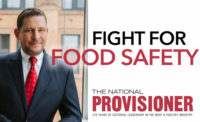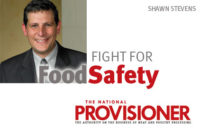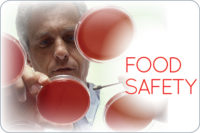Over the past century, the ways in which our food has been grown, manufactured, distributed and regulated have changed dramatically. There have been countless changes in food science and technology, and the consumer preferences that drive them. Food-safety awareness now stands at its highest level during the history of our nation. As we begin to ask ourselves what the next 100 years will bring, we would be well-served to use the last 100 years as our guide.
The past
A little more than 100 years ago, with advances in technology, the food industry began to better understand how to make food more accessible on a much larger scale. With improved preservation techniques and the emergence of rapid trans-national shipping, food processors for the first time in our nation’s history could produce and viably ship perishable products anywhere in the country.
At that time, however, the food industry was primarily regulated at the local level. In particular, the laws defining what constituted “adulteration” or “misbranding” were determined, if at all, by each individual state. As can be expected within a growing nation, industrial advances began to outpace the inherent limits of these local and non-uniform regulations.
In many cases, what was forbidden in one state was entirely lawful in another. Without a federal approach to food safety (and a single set of rules), there was no way to provide consumers with any confidence in the origins or safety of their food.
Advances outside the food industry inspired substantial change as well.
The creation of newspapers that for the first time served a national audience, gave individuals and consumer groups the opportunity to voice their concerns. Social reformers who otherwise would have remained unheard were also able to reach a broad audience.
The best-known example was Upton Sinclair, a man whose work ultimately led to the creation of the complex laws under which we operate today. Indeed, in his 1906 novel, The Jungle, Sinclair described in gruesome the unsanitary conditions prevalent in large meat slaughter plants. The book described unwholesome carcasses being processed for use in food, processing taking place in unhealthy conditions, and meat and other food products coming into contact with contaminants present in the plants.
These conditions outraged the public, and the U.S. Congress quickly realized that a uniform food-safety policy was essential to protect the health of the nation.
In 1906, Congress passed the Wholesome Meat Acts. This law for the first time mandated that federal inspectors be assigned to and present in beef slaughter and processing establishments, and continues to form the framework for the national food-safety laws that continue to exist to this day.
The present
As any involved in the industry knows, beef regulation has moved from the old organoleptic-based inspection system (sight, smell and touch) embraced in 1906 to a food-safety system that relies heavily on science and microbiology.
In the 1990s, the United States Department of Agriculture (USDA) began requiring that all meat and poultry processors adopt Hazard Analysis and Critical Control Point (HACCP) plans. Although this represented a revolutionary change in the way food was regulated, industry was able to successfully implement HACCP in thousands of plants in only a few years.
In the years since it was implemented, there can be little doubt that HACCP has been incredibly effective in improving the safety of our food supply. Indeed, in the last few years, there has been a drastic downward trend in the number and scope of recalls involving the presence of pathogens.
Moreover, in 2011, recognizing the success of HACCP in the meat industry, Congress passed the Food Safety Modernization Act (FSMA). FSMA will eventually require all FDA-regulated food companies to adopt and follow written food-safety plans using the HACCP methodology.
Food product testing has advanced considerably in recent years. Food companies now understand that if their food products are contaminated with pathogens when they leave the company’s control, there is in increased likelihood that those contaminants will be found. Indeed, more food processors are now sampling incoming raw materials and finished products before using or selling them.
Additionally, companies also recognize that if any existing contamination is not detected through product testing, there is a good chance that it will be found (if someone gets sick) by the Centers for Disease Control (CDC). Indeed, foodborne illness and outbreak surveillance has become so robust in recent years that if a food causes a foodborne illness or cluster, CDC and USDA investigators will in most cases be able to trace the offending product back to the company from which it originated.
In recent years, the media has also played a substantial role in increasing the overall quality and safety of our food. With more companies testing for pathogens, more pathogens are being found and more products are being recalled. In turn, through its reporting on outbreaks and recalls, the media has played a significant role in raising the overall awareness of food safety among U.S. consumers. In turn, U.S. consumers are now paying far more attention now to the origin, quality and safety of the food products they buy and eat. These trends will continue.
The future
If the past 100 years provides any glimpse into what the future holds for the food industry, the industry will likely be confronted with even greater change.
Reserving my own judgment, I firmly believe that we are moving as a nation toward a day when pathogens in all food products are fully controlled — as a matter of course. Consumer expectations have changed drastically over the last 100 years, and those expectations will continue to evolve.
As consumers continue to read about large-scale food-product recalls on the Internet and continue to watch stories about the human consequences of outbreaks on the news, Congress and the USDA will continue to be pressed by consumers and the media to respond.
This pressure from consumers and the media will not decrease in the future and will continue to shape food-safety policy. Whether we agree with it or not, we will reach a day in the future when consumers will no longer allow industry to sell raw animal products that carry a risk of making them sick. As interventions continue to advance, industry will respond by finding new ways to ensure that raw animal (and other) products are pathogen-free. Although this change cannot and will not happen overnight, I do believe that this change will come.
In the meantime, continue to do an outstanding job safely feeding a nation. Your work is important, and your contributions should be recognized.
Take exceptional pride in what this amazing industry has accomplished over the decades, and know this — just as it did during the last 100 years, the beef industry will continue to lead the way. Here too, history continues to be our guide.
The West wasn’t won on salads, after all. The West was won on beef.





Report Abusive Comment